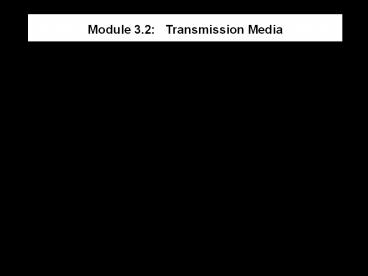Module 3.2: Transmission Media - PowerPoint PPT Presentation
Title:
Module 3.2: Transmission Media
Description:
Metal braid or sheathing that reduces interference. More expensive ... Future: satTV (eg: directTV) in your car. Most two-way systems struggling or bankrupt ... – PowerPoint PPT presentation
Number of Views:193
Avg rating:3.0/5.0
Title: Module 3.2: Transmission Media
1
Module 3.2 Transmission Media
- Electromagnetic Spectrum
- Guided Transmission Media
- Twisted Pair
- Coaxial cable
- Optical fiber
- Unguided Transmission Media
- Terrestrial Microwave
- Satellite
- Radio
- IR
- Cellular Telephony
2
Electromagnetic Spectrum
3
Guided Transmission Media
- Twisted Pair
- Coaxial cable
- Optical fiber
4
Twisted Pair
- Most common medium
- Telephone network
- Between house and local exchange (subscriber
loop) - Within buildings
- To private branch exchange (PBX)
- For local area networks (LAN)
- 10Mbps or 100Mbps
- Pros and Cons
- Cheap
- Easy to work with
- Low data rate
- Short range, about 100 meters.
5
Unshielded and Shielded TP
- Unshielded Twisted Pair (UTP)
- Ordinary telephone wire
- Cheapest
- Easiest to install
- Suffers from external EM interference
- Shielded Twisted Pair (STP)
- Metal braid or sheathing that reduces
interference - More expensive
- Harder to handle (thick, heavy)
- Capacity 10-155 Mbps
- UTP Categories
- Cat 3
- up to 16MHz
- Voice grade found in most offices
- Cat 4
- up to 20 MHz
- Cat 5
- up to 100MHz
- Commonly pre-installed in new office buildings
- RJ-11 vs. RJ-45
- RJ-11 is a typical UTP phone connector. Has 2
pairs. - RJ-45 is a UTP connector. Has 4 pairs.
6
Coaxial Cable
- Most versatile medium
- Television distribution
- Ariel to TV
- Cable TV
- Long distance telephone transmission
- Can carry 10,000 voice calls simultaneously
- Being replaced by fiber optic
- Short distance computer systems links
- Local area networks
- Transmission Characteristics
- Analog
- Amplifiers every few km
- Closer if higher frequency
- Up to 500MHz
- Digital
- Repeater every 1km
- Closer for higher data rates
7
Optical Fiber
- Greater capacity
- Data rates of hundreds of Gbps
- Smaller size weight
- Lower attenuation
- Electromagnetic isolation
- Greater repeater spacing
- 10s of km at least
8
Transmission Characteristics
- Act as wave guide for 1014 to 1015 Hz
- Portions of infrared and visible spectrum
- Light Emitting Diode (LED) used in MMF
- Cheaper
- Wider operating temp range
- Last longer
- Injection Laser Diode (ILD) used in SMF
- More efficient
- Greater data rate
- Wavelength Division Multiplexing (WDM) using
light prisms.
MMF vs. SMF
9
Comparison
10
Wireless Transmission
- Unguided media
- Transmission and reception via antenna
- Directional
- Focused beam
- Careful alignment required
- Omnidirectional
- Signal spreads in all directions
- Can be received by many antennae
- Frequencies
- 2GHz to 40GHz
- Microwave
- Highly directional
- Point to point
- Satellite
- 30MHz to 1GHz
- Omnidirectional
- Broadcast radio
- 3 x 1011 to 2 x 1014
- Infrared
- Local pt-pt confined area
11
Types of Radio Propagation
12
Microwave
- Satellite Microwave
- Satellite is relay station
- Satellite receives on one frequency, amplifies or
repeats signal and transmits on another frequency - Requires geo-stationary orbit
- Height of 35,784km
- GEO vs. LEO
- Frequency Bands C, Ku, and Ka
- Television
- Long distance telephone
- Private business networks
- Terrestrial Microwave
- Parabolic dish
- Focused beam
- Line of sight
- Long haul telecommunications
- Higher frequencies give higher data rates
13
Wide Area Satellite Systems
- Cover very large areas
- Different orbit heights
- GEOs (39000 Km), LEOs
- (2000 Km), MEOs (9000km)
- GEO is stationary. You need 3 to cover
- whole planet
- LEO and MEO orbit the earth every one hour
- Dish antennas, or bulky handsets
- Optimized for one-way transmission,
- location positioning, GPS systems, Satellite
Radio - Radio (XM, DAB) and movie (SatTV) broadcasting
- Killed MMDS wireless TV offerings.
- Future satTV (eg directTV) in your car
- Most two-way systems struggling or bankrupt
- Expensive alternative to terrestrial cellular
system (2G) - Trucking fleets, journalists in wild areas, Oil
rigs
14
LEO and MEO
- Used in GPS
- 24 MEOs are need to cover the whole planet
- 54 for LEOs to cover the whole planet
- Could have multiple readings for increased
precision and reliability.
15
WLAN
- Benefits of Ethernet WLAN
- Cheap
- Faster to deploy
- Mobility
- Watch for security
- Need for authentication
- Need for encryption during transmission
- What is an Access Point?
- A typical diameter is a room for one AP about 40
meters - Frequencies used and data rate
- IEEE 802.11b operates at 2.4 GHz range and gives
11Mbps - IEEE 802.11a operates at 5 GHz range and gives
54Mbps - IEEE 802.11g operates at 2.4 GHz range and gives
54Mbps - Bluetooth gives 1Mbps. Bluetooth networks PDAs
or cell phones with PCs. Operates in a short
diameter (10 meters). - Operates at 2.4 - 2.4835 GHz
- May have interference with Ethernet WLAN APs
16
Others
- IR (Infrared)
- Modulate noncoherent infrared light
- Line of sight (or reflection)
- Blocked by walls
- e.g. TV remote control, IRD port
- Broadcast Radio
- Omnidirectional
- FM radio
- UHF and VHF television
- Line of sight
- Suffers from multipath interference
- Reflections
17
Cellular System
Cellular Bands































